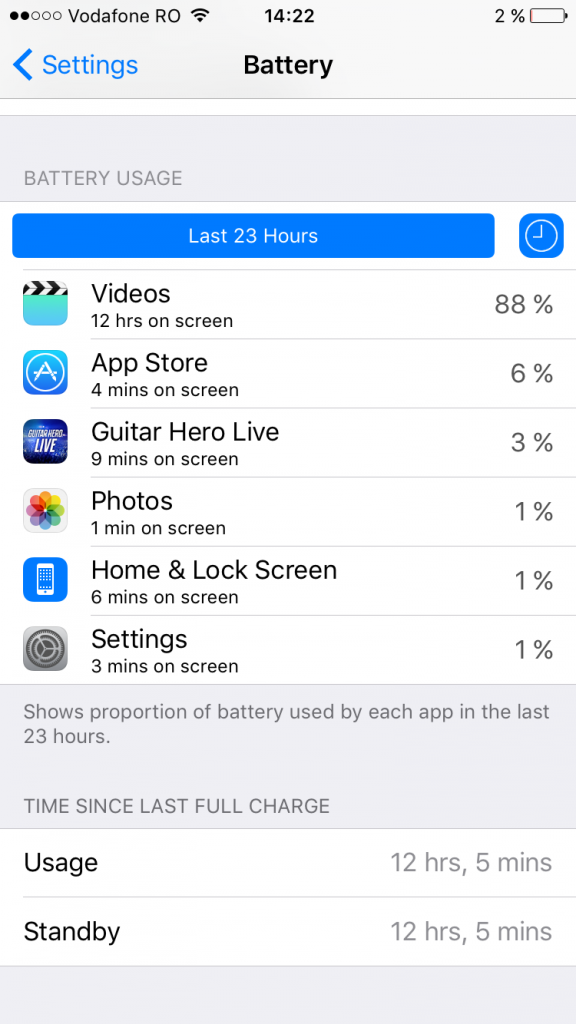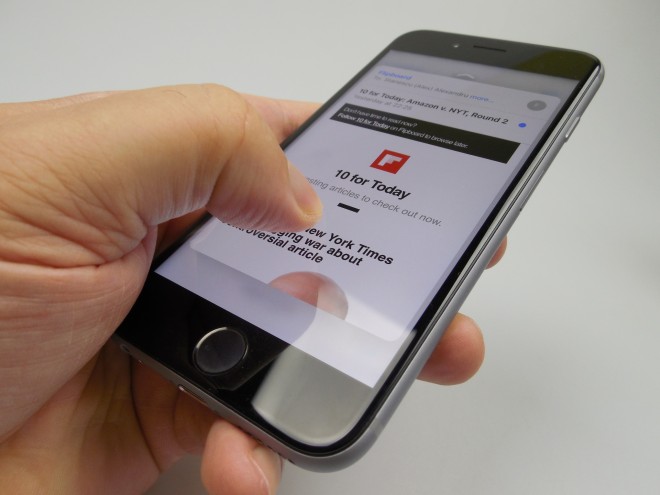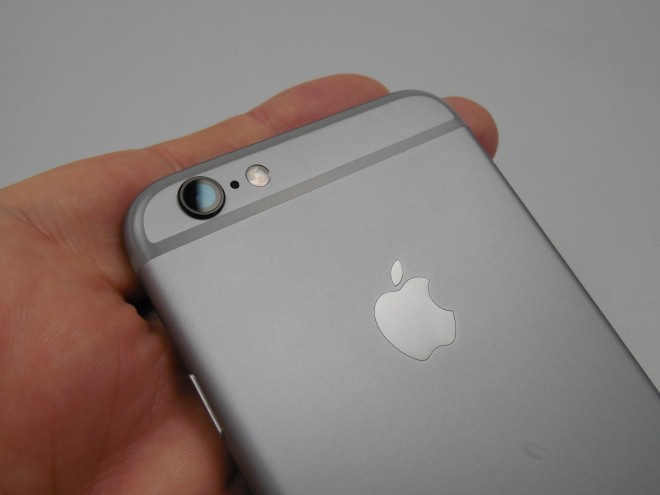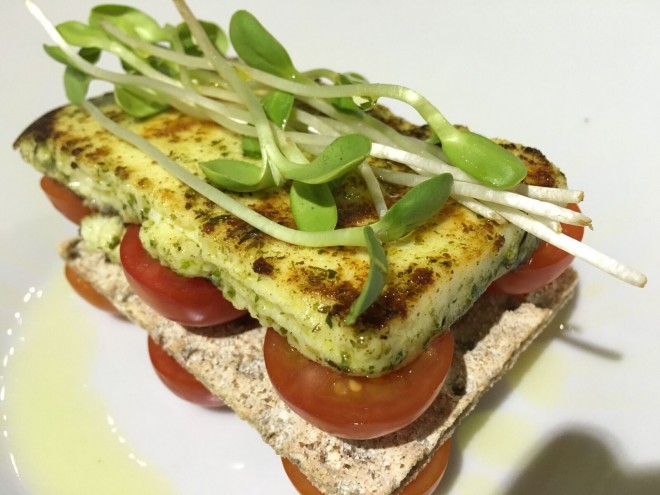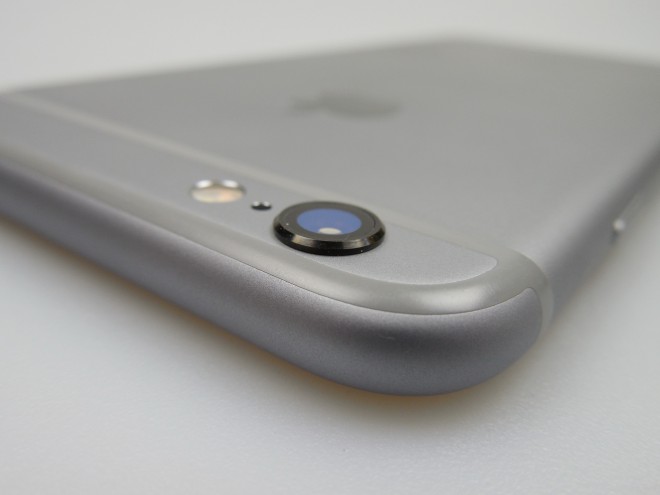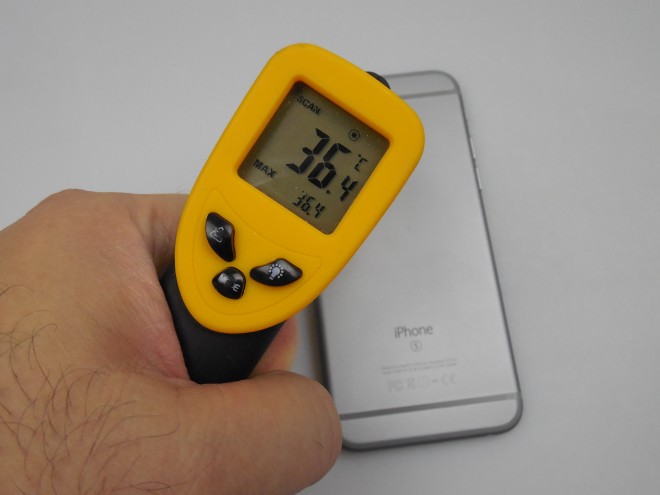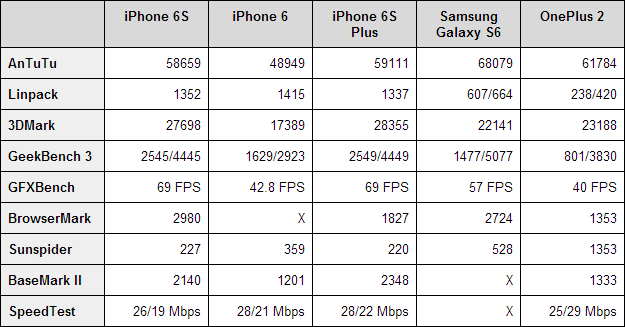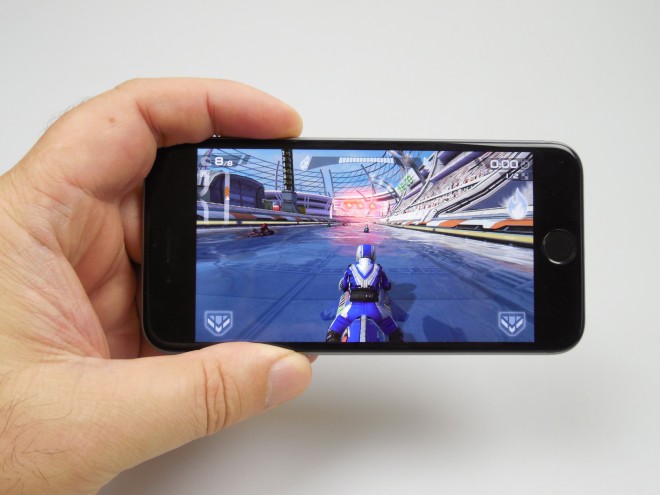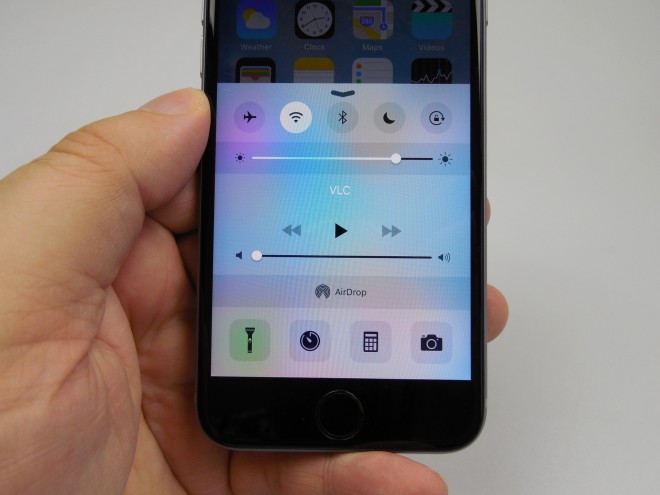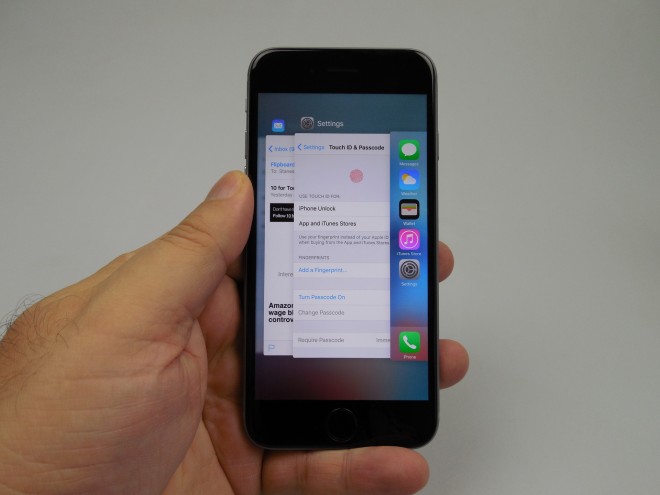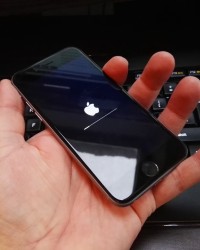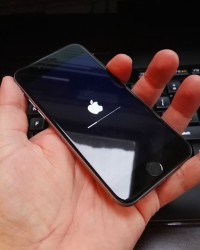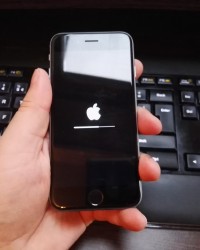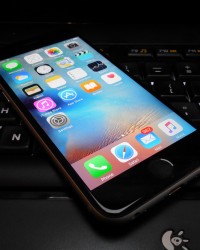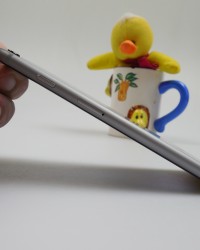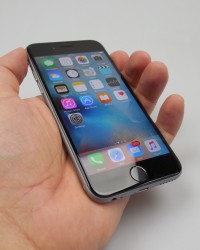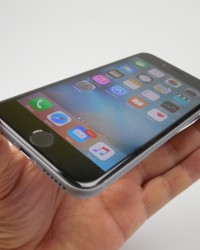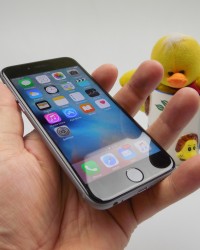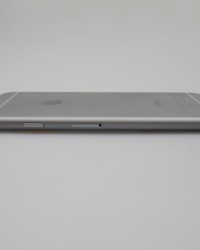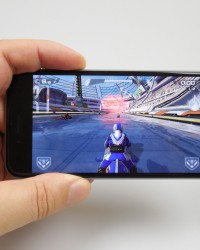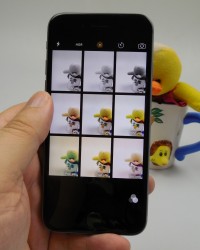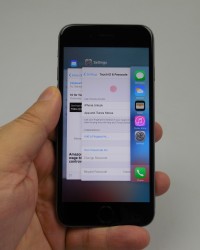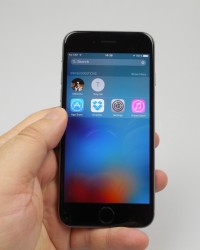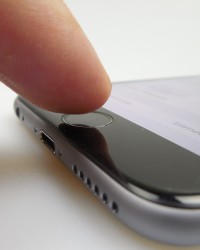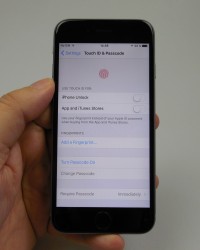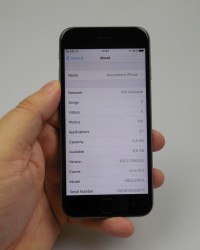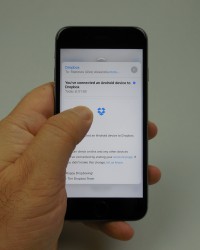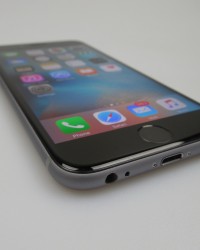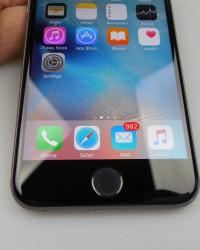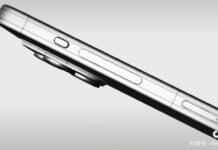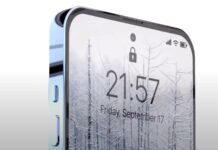We already reviewed the iPhone 6S Plus, as you probably already know and now it’s the turn of the iPhone 6S handset. Announced on September 9th, the product stands out through 3D Touch and the upgraded 12 megapixel camera. This is a 4.7 inch handset, priced at $649 in the 16 GB version in USA. It goes for $749 in the 64 GB version and $849 in the 128 GB version.
The smartphone is available in silver, gold and space gray, as well as rose gold. The phone measures 7.1 mm in thickness, weighs 143 grams, which means the iPhone 6S is 0.2 mm thicker and 14 grams heavier than its predecessor. The product has the same width and length as the iPhone 6, plus the same general format. I should also mention it’s thinner than the Xperia Z5 Compact, that measures 8.9 mm in waistline and it’s also heavier by 5 grams.
iPhone 6S is made of 7000 Series aluminum, more resilient than the material used for the older generation and it’s thus less prone to Bendgate. The chassis is an unibody aluminum one, with a solid and premium design and I have to say that the phone feels small by today’s standards. Some people still like a compact phone more than a phablet, the most popular handset segment this year.
As usual for an iDevice, bezels are quite big, especially the top and bottom part, that should change at some point. iPhone 6s offers good grip, it’s easy to use with one hand and upfront we find its earpiece, selfie camera, sensors, Home button with Touch ID and good feedback, plus a new type of glass made using dual Ion Exchange Process.
This new glass is supposed to be the most durable in smartphone industry and it’s a curved on the sides, especially where it meets the metal edges. At the back we’ve got the slightly protruding main camera with sapphire lens protection, microphone and flash, as well as the ugly plastic cutouts for the antennae.
There’s nothing at the top, while at the bottom we find the Lightning port, audio jack and speaker. Plus, there are two microphones there, one signalled by the usual hole and another one hidden in the first hole of the speaker. On the left side we can access the volume buttons and mute stich, both pretty comfy and on the right side there’s the Power button and nano SIM card tray, accessible with a metal pin.
Both edges are rounded for a much more comfortable holding than on angular devices. Overall, this is a smartphone with a premium build, compact case and also very comfy to use. On the hardware side, there’s a 4.7 inch Retina HD display in the mix, with 3D Touch and a 1334 x 750 pixel resolution, as well as the Apple A9 dual core processor clocked at 1.84 GHz.
This chipset has two versions: one made by Samsung (14 nm) and one by TSMC (16 nm), with Samsung theoretically making the more power hungry model. The GPU is a PowerVR GT6700 and we’ve also got the Apple M9 motion coprocessor on board, plus 2 GB of LPDDR4 RAM, unlike the iPhone 6, that had 1 GB of LPDDR3 RAM. Storage is available in 16, 64 or 128 GB versions and finally specs include a 12 megapixel back camera, 5 MP selfie camera and we move on to connectivity with the following options: LTE Advanced, WiFi 802.11 a/b/g/n/ac with MIMO, Bluetooth 4.2, NFC, GPS, Glonass and VoLTE. Sensors include Touch ID, barometer, 3 axis gyroscope, accelerometer, proximity sensor, ambient light sensor and digital compass.
My only regrets for hardware the starting version of just 16 GB instead of 32 GB, since we are filming 4K after all and wasting a lot of space with that. The battery on the iPhone 6S is a Li-Ion 1715 mAh unit, a decrease in capacity compared to the iPhone 6’s 1810 mAh. On paper the talk time is 14 hours and also on paper, the battery provides 11 hours of video playback, 50 hours of audio playback or 10 days of standby functioning. In our test, that involves HD video playback in a loop, with WiFi on and brightness at 200 LUX, we achieved 12 hours and 5 minutes which is great.
We surpassed the iPhone 6 and its 11 hours and 30 minutes, the iPhone 6 Plus (12 hours) and Galaxy S6 Edge+ (11 hours and 9 minutes). Still, we scored below the Allview P6 Energy (12 hours and 9 minutes), iPhone 6S Plus (15 hours and 8 minutes) and Lumia 1520 (17 hours). Charging takes 2 hours and 35 minutes, which is long compared to what Samsung achieves.
We still scored above the iPhone 6S Plus (2 hours and 57 minutes), Huawei P8 (2 hours and 47 minutes) and Xperia M5 (3 hours and 4 minutes). We were below the iPhone 6 (2 hours and 10 minutes, Galaxy S6 (1 hour and 10 minutes) and Galaxy S6 Edge+ (1 hour and 5 minutes). With mixed usage we got about one day, or one day and a half of regular usage.
Settings now include a Low Power Mode, that came about with iOS 9 and it has the role of reducing CPU usage, visual effects, backgrounds processes and guaranteeing one extra hour of functioning. On paper you also lose about 40% processing power from your device. There’s also the app battery usage shown next to each app in the battery area.
Overall the battery is excellent and our only regrets are the long charging and lack of wireless charge support. Now we move on to acoustics, with a single speaker at the bottom, that’s quite easy to cover with the hand in videogames and watching video. Apple Music is our main music player, with a lack of EQ, My Music section for your own tunes and the For You section for the Apple Music streaming service.
There’s New for new releases and Radio to connect to the celebrity-curated playlists of Beats 1 Radio. Finally, Apple Music features Connect, that lets you socialize with artists. The acoustic experience is loud and clear, the sound is crisp on all notes and there’s no distortion. The voice is a bid too loud, almost bothersome at max volume.
The speaker is good, but I’ve heard louder. Headphones bundled with the device are the usual Earpods, for the 4th year in a row. They’re comfy and elegant, have a long remote and they’re quite resilient. Also, they provide a loud volume, good bass, crisp sound and the have the major drawback of letting everyone hear what you’re listening to leak out.
We used a decibelmeter to measure the power of the speaker and achieved 81.7 dBA, which is a bit underwhelming. We beat the Amazon Fire Phone (75.7 dBA), Xiaomi Mi 4i (72.1 dBA) and Huawei Mate (80.7 dBA). We scored below the Huawei P8 Lite (82.9 dBA), iPhone 6 (85.2 dBA) and iPhone 6S Plus (84.2 dBA). In the Settings area we finally find the equalizer, with options like Acoustic, Bass Booster, Bass Reducer, Dance, Flat and other genre presets. Then there’s Volume Limit and Soundcheck.
Now let’s talk about the display, a 4.7 inch Retina HD panel, with LED backlight and IPS LCD technology. It offers a 1334 x 750 pixel resolution, 326 ppi density, 1400:1 contrast ratio and keeps the same resolution and diagonal as the predecessor. The iPhone 6S has the full sRGB standard and relies on oleophobic coating to keep fingerprints away.
The Videos app is pretty basic, without subs or special options. The viewing experience brings a bright image, vivid and realistic colors, no reflectivity and wide view angles. Contrast and behavior in full sunlight are quite good, but the blacks are not deep. We’ve got RGB Stripe pixels in the mix and we achieved a brightness of 618 LUX when we used a luxmeter to measure it.
This puts us above the iPhone 6S Plus (573 LUX), OnePlus 2 (465 LUX) and iPhone 6 (570 LUX), as well as the iPhone 6 Plus (605 LUX). We scored below the Galaxy Note 5 (in sunlight 747 LUX), Galaxy S6 Edge (in sunlight 933 LUX) and Galaxy s6 Edge+ (705 LUX). The Settings for the screen include Display Zoom (standard and zoomed), text size and bold text. This is a great screen, but I’ve been brighter and the resolution feels strange in this day and age. The LG G4 also has more realistic colors.
3D Touch brings 96 capacitive sensors and it measures degrees of pressure, plus offers a new taptic engine for feedback that feels like the one on the Apple Watch, only amplified. The core feature of 3D Touch is Peek and Pop, with Peek letting you blur the screen around an email from the Mail app or a site opened up from a link, in order to highlight it. This happens after tapping on it stronger than a regular tap.
If you keep pressure on and press harder a bit that triggers Pop, which takes you to the actual site/mail. With Peek you could just preview it. Between Peek and Pop you can also swipe up to view sharing options for example. 3D Touch also makes Live Photos come to life and then we’ve got the Quick Action menus, that appear when you hard press an icon on the homescreen. For example hard pressing the Camera icon, shows options like slow motion, selfie, video or photo.
You can also hard press on the left side of the homescreen to trigger a multitasking preview. 3D Touch enables pressure sensitive drawing in notes as well, by the way. Text selection is available too, by tapping and holding to look up a word or letter and then pressing hard and holding to select the text. Overall, the screen is excellent, aside from the atypical resolution and now we move on to the camera.
After a few years of 8 megapixel shooters, we’ve finally upgraded to 12 megapixels at the back and 5 MP upfront. The main camera uses 1.12 micron pixels, has no optical image stabilization and relies on a True Tone flash. It takes panoramas at up to 63 megapixels and has F/2.2 aperture, plus it offers a 5 element lens, hybrid IR filter and BSI. The same camera has a sapphire lens cover and it does 4K video capture. As a point of reference the iPhone 6 had 1.5 micron pixels, so the pixel size has decreased.
Behind this camera lies a Sony sensor that measures 1/3 inches. Upfront we’ve got a 5 megapixel camera, with F/2.2 aperture, 1/5 inch sensor and 1.22 micron pixels. The front camera uses a special “flash” system, that makes the screen 300% brighter, acting pretty much like a flash. The predecessor only had a 1.2 MP selfie camera, so that’s quite the upgrade.
The Camera app opens up fast and displays the typical iOS UI, with white font and minimal options. To the left we find the front camera shortcut, timer and Live Photos. That option lets you take a moving shot, much like a GIF or Vine and it’s basically a 3 second video, with 1.5 seconds captured before you press the shutter button and 1.5 seconds after.
A little audio and video is captured with Live Photos, with the video at 14 FPS and a resolution of 1440 x 1080 pixels. Such a vid takes up 3 or 4 MB of space. HDR is here as well and flash options are included in the UI too. The right side of the UI brings 8 filters, Panorama mode, Square, Photo, Video, Slow Motion and Time Lapse.
The Gallery has a Peek and Pop feature of its own and now let’s get to the actual camera experience. The picture taking and focus are very fast, while the zoom is fluid. We’ve got an exposure slider and if you keep the screen pressed, you can achieve AE/AF lock. In order to tweak video capture options, you need to access the Settings/Camera area, where you can find options like 720p at 30 FPS, 1080p at 30 or 60 FPS, 4K at 30 FPS and slow motion in Full HD at 120 FPS or HD in 240 FPS.
We created a gallery of pictures in mid November, in mostly sunny conditions, but we started with some gourmet indoor shots, with nice food texture a and shiny piece of grilled cheese, very nicely captured. Good clarity here and a crisp selfie was also taken indoors. We also zoomed into a funny name for a restaurant, but it was night, so the shot was grainy.
Outside we took a series of crisp shots of a cat, that looked lovely, including some 3D Touch ones. Then we captured some shots in full sunset, with impressive zoom quality on the top of that building. Panorama was very wide and clear, with a resolution of 16362 x 3646 pixels. The indoor shots we did next had OK colors and lighting and the selfie I took was kind of artificial-looking.
Then we switched again to day time, for a gallery inside a park. HDR made images slightly brighter, but nothing over the top. It was a bit more cloudy on that day in the park and we registered some realistic colors, nice leaves texture and caught moving birds in action nicely with Live Photos. There was some detail loss when I zoomed in, keep that in mind.
Selfies were crisp, but somehow they felt below the quality achieved with the iPhone 6S Plus and Galaxy S6. The background was particularly disappointing there. Colors, exposure and white balance were generally good here, as was the focus. We did a nice closeup of a red police light on a toy car, with a bokeh effect created even.
Landscape shots were OK, but I’ve seen better on other flagships. Panorama number 2 is spectacular and it’s very clear, nice and detailed. Finally, we had a few macros and bokeh style shots of a metal acorn and we played with the focus in tandem with the ducks in the background, on the lake surface. Overall, I’d say that during the day the iPhone 6S is below the LG G4, Galaxy S6 and Galaxy S6 Edge, as well as the iPhone 6S Plus. There’s detail loss when zooming in and selfies were OK, but their background was not.
We did capture more details than on the iPhone 6 and colors were more realistic than on that model. The images were just as crisp though. There’s less of a premium gloss here compared to what we achieved on the Galaxy S models, to be frank. There’s no shine, that extra special something to want to frame a poster of a picture, like on the LG G4.
During the night, we did some low light capture and found out we have a very good flash to work with, sometimes even too powerful and spoiling landscape shots. Without flash things got grainy fast and I’d say that quality is clearly below the LG G4 offering. Street light halos are quite big and the performance is pretty much on par with the iPhone 6S Plus, maybe a bit below that.
Lighting and colors are OK and quality could be a improved a pinch. Flash works wonders in closeup, but spoils the fun in distance shots. Selfies looked fantastic at night, courtesy of the screen flashing at 300% brightness. Once again, we consider that this iPhone is below the LG G4 and Galaxy S6 Edge+ at night, but only by about 15%. The performance is identical to the iPhone 6, that took some really good night shots.
As far as videos go, we had a first capture of a sunset view, in Full HD at 30 FPS and 17 Mbps bitrate. This video had an OK exposure change, good clarity and colors. Then we did a day time Full HD capture in 30 FPS and with 18 Mbps bitrate, but the scenery was cloud and wasn’t very impressive. Colors were OK, but the clarity could have been better.
Slow motion vids of the gulls and other birds looked fine and the fourth video brought on digital stabilization testing. We climbed and descended stairs, only to be impressed by how well the stabilization handles everything, even without OIS. There was also a Full HD 60 FPS video taken, with 27 Mbps bitrate and very crisp. The microphones also handled the wind in excellent manner and there was no focus loss when descending stairs.
The sixth video had realistic colors, good exposure change and then we did another video with the gulls, at 60 FPS and with great details when zooming. Video 8 had good acoustics and focus and finally the 4K clip is very crisp, has perfect quality and even keeps it when zooming in. During the day, the colors and exposure are clearly improved from the iPhone 6 when filming.
The iPhone 6S Plus was crisp enough to get from us the tagline “handycam killer”, since it pretty much filmed perfectly. iPhone 6S isn’t far behind, with excellent digital stabilization, but the quality is in my book not on par with the excellent LG G Flex 2 or big Samsung Galaxy models this year. Night time video capture had OK clarity, decent brightness and colors, but it was a bit on the dark side and the bitrate dropped to 5 Mbps.
The flash didn’t help very much, only made the colors better. Strangely, I went back and saw some iPhone 6 low light videos and they actually felt better than the ones of the iPhone 6S… So, overall this is a good camera, but good doesn’t cut it in 2015, you need excellent like on the LG G4 (minus the video), Galaxy S6 and the Edge models, plus the iPhone 6S Plus. The lack of excellence may be a problem for perfectionists, while Instagrammers and 99% of buyers will be happy with the current camera.
Editing is done with the usual rotate, crop and filters options, as well as Light, Colors and B+W. We did a temperature test here, by playing the game Riptide GP2 for 15 minutes and achieved 36.4 degrees Celsius, so there’s no overheating here, luckily. We also tested Safari, which proved to be fast and now features a “Find on Page” option and lets you request a desktop site by keeping pressed the refresh button.
The virtual keyboard is comfy even on the smaller diagonal, so no objections here neither. On the connectivity side, we were happy with LTE-A, VoLTE, excellent call quality and signal, both for WiFi and cellular. GPS also found us fast and FaceTime looked picture perfect. Then we did some benchmarks, pitting the iPhone 6S against the iPhone 6, iPhone 6S Plus, Galaxy S6 and OnePlus 2. The battle is actually between the Apple A9 + 2 GB RAM, Apple A8 + 1 GB RAM, Apple A9 + 2 GB RAM again, Exynos 7420 + 3 GB RAM and Snapdragon 810 v2.1 + 4 GB RAM.
Here are the results:
The iPhone 6S wins 2 out of 9 battles, but the iPhone 6S plus is the culprit here, since it’s only a bit better than the smaller model. Compared to the iPhone 6 we won 7 out of 9 battles. The handset doesn’t have lag and runs games perfectly, plus it has a fluid UI. Now let’s talk about iOS 9. We already detailed a ton this release in the iPhone 6S Plus review, so I’m going to focus on essential novelty this time.
The UI is the same as the one in iOS 8 and 7, but we get a new font, San Francisco, more elegant and rounded this time. If you swipe down, the today view, notifications and widgets haven’t changed, well maybe the chronological display of the notifications may be a novelty here. If you swipe up you can access the Control Center, with connectivity options, brightness and volume slider, as well as 4 app shortcuts and Airdrop.
Touch ID is now much faster and foolproof, plus it’s secured by a 6 digit password, but not as secured as on Samsung devices, that require alphanumeric passwords. Siri gets a new animation and Hey Siri can be tailored to your voice alone via a setup process. You can now trigger “Hey Siri” without putting the phone to charge, unlike iOS 8.
Siri can provide feedback in 3 modes: Always On, Ring Switch and Hands Free. The same assistant is able to find pictures from a certain event or place and when you say “Remind me of this” when in an email or web page, said mail or page will be reminded to you. Siri can update your Facebook status, tell jokes, flip a coin, roll dice and book a reservation.
You can dictate an email using it and it can try to find the identity of an unknown caller using the emails you got from that person. Spotlight now integrates Siri Suggestions, such as contacts and apps you access a lot. After further use, your favourite sports team, weather and nearby restaurants will be shown in the same area.
Spotlight is able to do math on the go and when searching, it pulls up contacts you can call straight from it or message, plus it also shows info from the web, emails and apps. Apple included here something called Proactive Suggest, that shows the mail when you’re going home and suggests a contact when you’re writing an email, so basically info before you know you need it.
Multitasking has a new look, a horizontal scrolling carousel and users can now select pictures in bulk by selecting one and keeping pressed the screen, while moving the finger around. With iOS 9 you can now zoom into videos, hide pictures, stream HiFi music on cellular connections and use WiFi Assist. Transit directions are available in Apple Maps and the keyboard now features lowercase and uppercase letters.
The Notes app has been upgraded, with a checklist feature, a very intuitive ruler and drawing pen tips and colors. There’s heading/body/bullets options and Safari now comes with an improved reading mode with extra font and background options. Apple News is also part of the package, as an extra compared to the usual apps.
Apple Pay now holds loyalty cards and iCloud Drive can be shown on the homescreen now. A major update is the inclusion of a Back button, that appears for example when you tap on a link on Facebook and head into the article. The back button is placed at the top left side of the screen, kind of covering up the connectivity symbols.
Finally, there’s a search bar in settings, new items have been included in Apple Health and when attaching pictures to the Mail app (email attachments), you can do a ton of new editing with Markup. It includes magnifying glass options, text, signature, colors and more. And now let’s see the preinstalled apps list, that luckily lacks bloatware:
Messages
Calendar
Photos
Camera
Weather
Clock
Maps
Videos
Wallet
Notes
Reminders
Stocks
iTunes Store
App Store
iBooks
Health
Settings
Facetime
Calculator
Podcasts
Watch
Game Center
Compass
Tips
Voice Memos
Contacts
Find Friends
Find iPhone
And now it’s time for the verdict and we start off with the Pros and Cons.
Here are the Pros:
premium materials and build
comfy
excellent battery
very bright screen
3D Touch is the future
great colors in pictures
good focus
excellent digital stabilization
great performance
more mature iOS
And the Cons:
atypical resolution
16 GB storage start version
long charging
no wireless charging
audio could be better
less premium look of pictures compared to rivals
flash too bright often times
This handset stands out through premium design, a very solid battery and good selfies. Of course, the screen is very bright, but the camera and acoustics don’t have that degree of excellency to them, like Apple used to deliver. Performance is still top notch and you basically can’t find a higher end phone below 5 inches on the market right now.
It’s still not a huge jump from the iPhone 6, that itself was a quality device and for the current phablet craze, this is a rather small device. Still, there are many people looking for more compact handsets and aside from the Xperia Z5 Compact, this is the ideal option right now.






